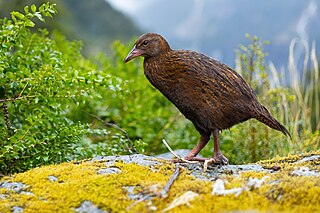
The weka, also known as the Māori hen or woodhen is a flightless bird species of the rail family. It is endemic to New Zealand. Some authorities consider it as the only extant member of the genus Gallirallus. Four subspecies are recognized but only two (northern/southern) are supported by genetic evidence.

The bushwren, also known as the mātuhituhi in the Māori language, was a very small and almost flightless bird that was endemic to New Zealand. It had three subspecies on each of the major islands of New Zealand, the North Island, South Island, and Stewart Island / Rakiura and nearby smaller islands. The species disappeared gradually after the introduction of invasive mammalian predators, last being seen on the North Island in 1955 and the South Island in 1968. Attempts were made to save the remaining population on small islands off Stewart Island, but they ultimately failed with the death of the last remaining known birds in 1972.

The Museum of New Zealand Te Papa Tongarewa is New Zealand's national museum and is located in Wellington. Usually known as Te Papa, it opened in 1998 after the merging of the National Museum of New Zealand and the National Art Gallery. An average of more than 1.1 million people visit every year, making it the 58th-most-visited art gallery in the world in 2023. Te Papa operates under a bicultural philosophy, and emphasises the living stories behind its cultural treasures.

The laughing owl, also known as whēkau, the jackass, or the white-faced owl, is an extinct species of owl that was endemic to New Zealand. Plentiful when European settlers arrived in New Zealand, its scientific description was published in 1845, but it was largely or completely extinct by 1914. The species was traditionally considered to belong to the monotypic genus Sceloglaux Kaup, 1848, although recent genetic studies indicate that it belongs with the boobook owls in the genus Ninox.

The upland moa is an extinct species of moa that was endemic to New Zealand. It is a ratite, a grouping of flightless birds with no keel on the sternum. It was the last moa species to become extinct, vanishing around 1500 CE, and was predominantly found in alpine and sub-alpine environments.

The New Zealand quail, or koreke in Māori, is an extinct quail species endemic to New Zealand. The male and female were similar, except the female was lighter. The first scientist to describe it was Sir Joseph Banks when he visited New Zealand on James Cook's first voyage. Terrestrial and temperate, this species inhabited lowland tussock grassland and open fernlands. The first specimen to be obtained by a European was collected in 1827 by Jean René Constant Quoy and Joseph Paul Gaimard on Dumont D'Urville's voyage. It most likely went extinct due to diseases from introduced game birds.

Cranfillia fluviatilis, synonym Blechnum fluviatile, is a fern known in the Māori language as kiwikiwi. A herbaceous plant, C. fluviatilis is a "hard fern" of the genus Cranfillia in the family Blechnaceae. It was identified by Patrick Brownsey in 1979. Other common names are star fern, creek fern, kawakawa and kiwakiwa.

Cytora is a genus of very small air-breathing land snails, terrestrial pulmonate gastropod molluscs in the family Pupinidae. This genus is endemic to New Zealand.

Cytora hirsutissima is a species of very small land snails with an operculum, terrestrial gastropod molluscs in the family Pupinidae.
Marilynn Lois Webb was a New Zealand artist, noted for her contributions to Māori art and her work as an educator. She was best known for her work in printmaking and pastels, and her works are held in art collections in New Zealand, the United States, and Norway. She lectured at the Dunedin School of Art, and was made an emeritus principal lecturer in 2004.
Bruce Anders Marshall is a New Zealand taxonomist and malacologist. He is an expert on New Zealand mollusca and has named hundreds of species and genera.

Cantuaria abdita is a species of trapdoor spider endemic to New Zealand.

Kapanga grana is a species of Dwarf sheet spider that is endemic to New Zealand

Neoramia hokina is a species of Stiphidiidae that is endemic to New Zealand.

Tangata rakiura is a species of araneomorph spider of the genus Tangata. The species is endemic to New Zealand

Ascuta australis is a species of orsolobidae spider of the genus Ascuta. The species is endemic to New Zealand

Porrhothele quadrigyna is a species of Mygalomorphae spider endemic to New Zealand.
Magnoteuthis osheai is a species of squid in the genus Magnoteuthis. The species has been observed off the coast of New Zealand.

Nomaua rakiura is a species of Physoglenidae spider endemic to New Zealand.

















